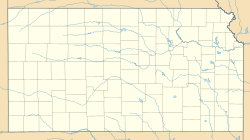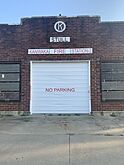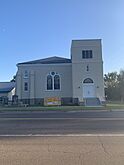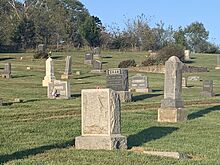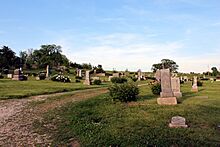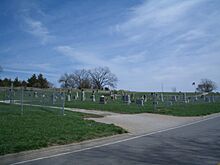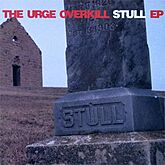Stull, Kansas facts for kids
Quick facts for kids
Stull, Kansas
|
|
|---|---|
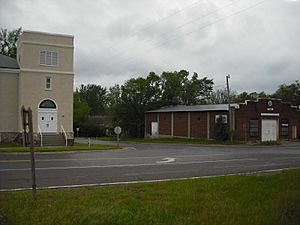
A view of Stull looking southwest. The building on the left is the Stull United Methodist Church, and the building on the right is the fire station.
|
|
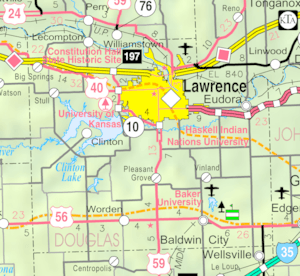
|
|
| Country | United States |
| State | Kansas |
| County | Douglas |
| Founded | 1857 |
| Named for | Sylvester Stull |
| Elevation | 942 ft (287 m) |
| Time zone | UTC-6 (CST) |
| • Summer (DST) | UTC-5 (CDT) |
| ZIP code |
66050
|
| Area code | 785 |
| FIPS code | 20-68725 |
| GNIS ID | 479114 |
Stull is a small community in Douglas County, Kansas, United States. It's not a city with its own local government, so it's called an unincorporated community. Stull was started in 1857 and was first known as Deer Creek. It was later renamed after Sylvester Stull, who was the town's only postmaster. As of 2018, only a few buildings remain in the area.
Since the 1970s, Stull has become famous because of a spooky story. This story claims that the nearby Stull Cemetery is a place where evil forces are at work. This legend has become a popular part of American culture and has been mentioned in many movies, TV shows, and books. However, this legend has also caused problems for the people who live in Stull.
Contents
Where is Stull Located?
Stull is found in Douglas County, Kansas, at 38°58′16″N 95°27′32″W / 38.97111°N 95.45889°W. It's about 7 miles (11 km) west of Lawrence and 10 miles (16 km) east of the city limits of Topeka.
Stull's Past: A Look Back
How Stull Began
Stull first appeared on maps in 1857. Back then, it was called Deer Creek. No one is quite sure where this name came from. Some people think it might have been an old Native American name. Others believe it came from someone seeing a deer near a body of water. The first European settlers in the area spoke German. Many of them came from Pennsylvania Dutch Country. Others had left the German Confederation to find more freedom and avoid military service.
The 1800s in Stull
In the late 1850s, the families living in Deer Creek started a church. They met in people's homes until 1867. That year, they built a stone church called the Evangelical Emmanuel and Deer Creek Mission. It later became known as "Evangelical Emmanuel Church." Until 1908, church services were held in German.
In 1867, a cemetery was also started next to the church. In 1922, the people of Stull raised money to build a new wooden church across the road. The next year, the church changed its name to "Stull Evangelical Church." The old stone church was left empty in 1922 and slowly fell apart. It was finally taken down in 2002.
Because more people joined the church from Stull and Lecompton, a bigger church was needed. In 1919, the community decided to build a new one. This new church was built in 1922 and later became the "United Methodist Zion Church" in 1968. Today, it is called Stull United Methodist Church and still holds services.
In the late 1890s, a telephone switchboard was put in the house of a Stull resident named J. E. Louk. Soon after, on April 27, 1899, a post office opened in the same building. The town's first and only postmaster was Sylvester Stull. The town was named after him. The name Stull stayed even after the post office closed in 1903.
Stull residents opened two schools before Kansas became a state. The first school only lasted about five years. The other school, named "Deer Creek," had more and more students. It was also used for church services by different groups on Sundays. Besides school and church, the building hosted debates, voting for elections, and fun competitions like baseball and sewing. This school closed in 1962, and students then went to Lecompton for their education.
Farming brought new hope to the community and is still how many of the remaining residents make a living. Building the Clinton Reservoir changed road routes and farming areas. While some farms were lost, it helped Stull and nearby communities grow.
The 1900s in Stull
In 1912, only 31 people lived in the Stull area. At its biggest, the community had about 50 people. Christ Kraft, who lived there in the 1900s, remembered life in the small town as "quiet and easy, sometimes even boring." Before cars were common, trips to Lecompton, Lawrence, and Topeka took two, three, and four hours, respectively.
In the early 1900s, organized baseball became popular. Stull residents played in a league with people from other communities near Clinton Lake, like Clinton and Lone Star. Eventually, a baseball field was built in Stull. Hunting rabbits was also a popular activity during this time.
Several businesses started in Stull during the early 1900s, but most didn't last long. One exception was the Louk & Kraft grocery store, which opened in the early 1900s and stayed open until 1955. The Roaring Twenties brought talks about building a train line between Kansas City and Emporia that would go through Stull. Thinking their town was about to grow, Stull residents discussed starting a "Farmers State Bank." However, neither the train line nor the bank were ever built, possibly because of the Great Depression.
During the 1900s, the community experienced two sad events. One happened when a young boy named Oliver Bahnmaier walked into a field his father was burning and died. This led to a rumor that stepping on Oliver's tombstone would send you to a bad place. The second event was when a man was found hanging from a tree after he had gone missing.
Stull in the 2000s
On July 25, 2022, the new Stull church caught fire between 1 p.m. and 1:30 p.m. No one was hurt, but the building was badly damaged. Officials think the fire was caused by a lightning strike.
Because of vandalism, the Stull Cemetery is locked at night. Police officers patrol the area. If you are caught trespassing, you could face up to six months in jail or a fine of up to $1000.
The Spooky Legend of Stull Cemetery
The Stull Cemetery has a scary reputation because of urban legends. These stories involve Satan, magic, and a supposed "gateway to Hell." The rumors became popular in November 1974 after an article in The University Daily Kansan, the student newspaper of the University of Kansas. It claimed that the Devil appeared in Stull twice a year: on Halloween and on the first day of spring.
People soon started saying that the cemetery was one of the seven gates to Hell. They also said that the old, ruined Evangelical Emmanuel Church nearby was "possessed" by the Devil. There's even a story that the Pope changed his plane's route in the 1990s to avoid flying over Stull because it was considered unholy ground. However, there is no proof that this ever happened.
Most experts, historians, and local residents agree that these legends are not true. They believe the stories were made up and spread by students. Some of the spooky tales include:
- "Folks swear an old tree in the graveyard once served as gallows for condemned witches who return each year as Satan's army."
- "They say that in the basement of the abandoned church in Stull, Kansas, there is a staircase. And if you follow that staircase, down, down, down, you will reach the entrance to hell, itself."
- "They say on the night before Halloween, a woman in a white dress lures drivers to their death along the highway's edge, never to be seen again."
After the University Daily Kansan article came out, many people who loved a thrill visited the cemetery. They would claim that strange things happened to them, like hearing noises or forgetting things. This led to more rumors that the town was haunted by witches and the Devil.
It became popular for young people, especially high school and college students from Lawrence or Topeka, to go to the cemetery on Halloween or the first day of spring to "see the Devil." Many would climb fences or sneak onto the property. Over the years, as more people visited, the graveyard started to get damaged by vandals. To stop this, the county sheriff's office patrols the area around the cemetery, especially on Halloween. They will arrest people for trespassing. Those caught inside the cemetery after it is closed could face a large fine and jail time.
Images for kids


